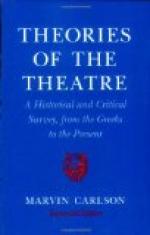Likewise, on a larger scale, the layman habitually fails to distinguish between a mere theatric entertainment and a genuine drama. A genuine drama always reveals through its imagined struggle of contesting wills some eternal truth of human life, and illuminates some real phases of human character. But a theatric entertainment may present merely a deftly fabricated struggle between puppets, wherein the art of the actor is given momentary exercise. To return to our comparison, a genuine drama is carved out of marble, and incorporates, consciously or not, the Intention of Permanence; whereas a mere theatric entertainment may be likened to a group of figures sculptured in the sand.
Those of us who ask much of the contemporary theatre may be saddened to observe that most of the current dramatists seem more akin to the sand-man than to Praxiteles. They have built Courts of Honor for forty weeks, rather than temples to Poseidon for eternity. Yet it is futile to condemn an artist who does a lesser thing quite well because he has not attempted to do a greater thing which, very probably, he could not do at all. Criticism, in order to render any practical service, must be tuned in accordance with the intention of the artist. The important point for the critic of the sand-man at Coney Island is not to complain because he is not so enduring an artist as Praxiteles, but to determine why he is, or is not, as the case may be, a better artist than the sand-man at Atlantic City.
X
THE QUALITY OF NEW ENDEAVOR
Many critics seem to be of the opinion that the work of a new and unknown author deserves and requires less serious consideration than the work of an author of established reputation. There is, however, an important sense in which the very contrary is true. The function of the critic is to help the public to discern and to appreciate what is worthy. The fact of an established reputation affords evidence that the author who enjoys it has already achieved the appreciation of the public and no longer stands in need of the intermediary service of the critic. But every new author advances as an applicant for admission into the ranks of the recognised; and the critic must, whenever possible, assist the public to determine whether the newcomer seems destined by inherent right to enter among the good and faithful servants, or whether he is essentially an outsider seeking to creep or intrude or climb into the fold.




